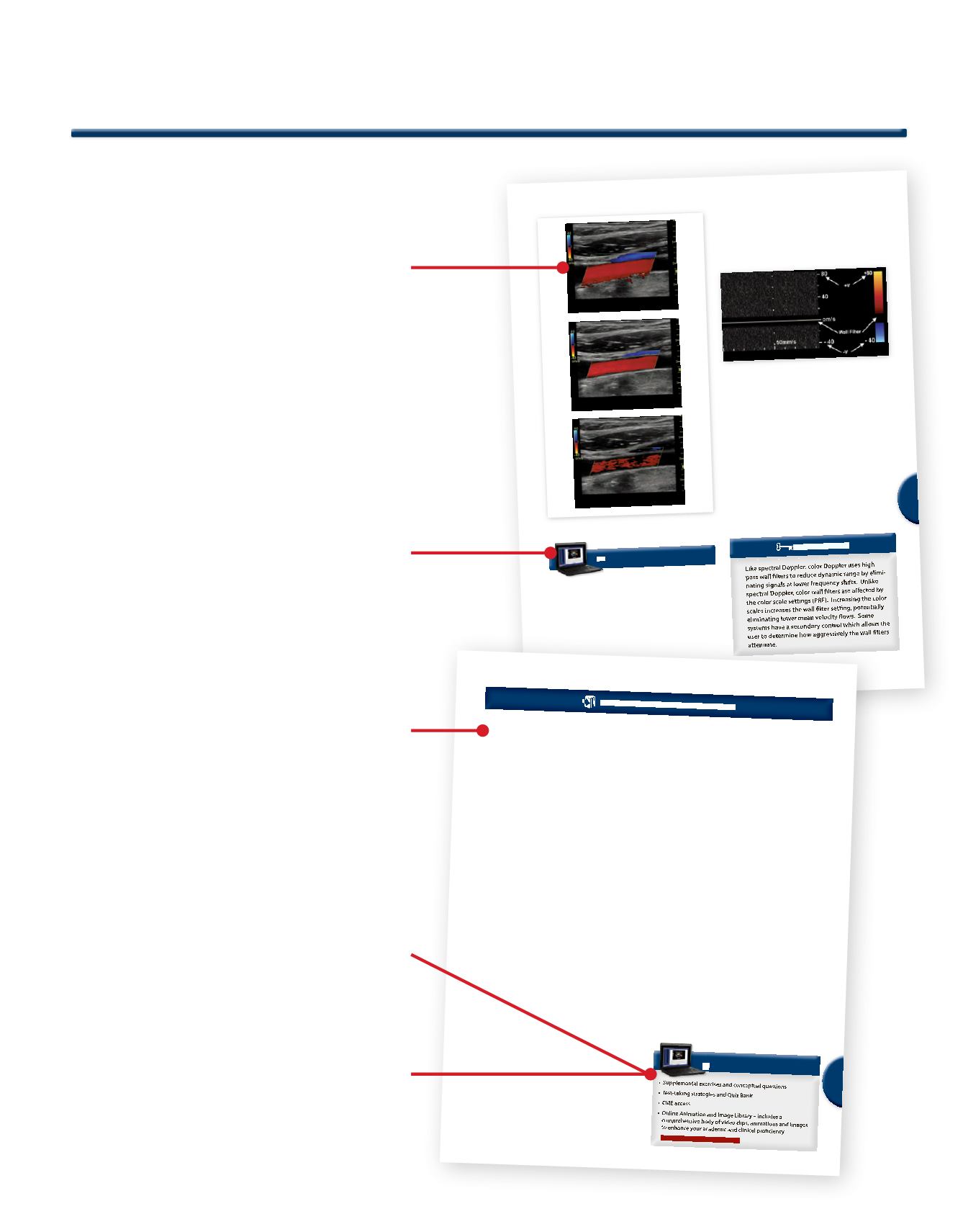
Preface
ix
Chapter7: Doppler
257
7
Fig.48b
Overgain,appropriategain,andundergain
VIEWONLINE ANIMATION AND IMAGE LIBRARY
25. Interpreting the Color Bar Relative to
Spectral Doppler
Recall that directionality is known from the Doppler equation by
determining if the Doppler shi is positive or negative relative to
the operating frequency. Flow towards the transducer creates a
positive frequency shi ,while flow away from the transducer cre-
ates a negative frequency shi . In spectral Doppler, the direction
is indicated by whether the flow is presented above or below the
baseline, unless spectral invert is activated, which results in flow
towards the transducerdisplayedbelow thebaselineandflowaway
fromthetransducerdisplayedabovethebaseline. ForcolorDoppler,
directionality is indicatedby the colorson the colorbar. Using the
figurebelow,youshouldnote thesimilaritiesbetween thecolorbar
and thedisplayparametersof theDoppler spectrum.
Fig.49
Colorbar relation to spectraldisplay
26. Color Invert and Aliasing
Just as with invert or spectral Doppler, attention must be paid to
whetherornotthecolor invert ison,soastoappropriatelydetermine
flowdirection.Forthecolorbar in
Figure49
,sincecolor invert isnot
on,flow towards the transducer isrepresentedby thecolorabove the
baseline(red in thiscase). InspectralDoppler,highervelocityflows
are representedhigherabove thebaseline.Similarly,as thevelocity
increases,thecolor transitionsup thecolorbar (fromshadesof red
toshadesofyellow for thiscolorbar). If thevelocity,or,equivalently,
frequency shi ,goes beyond the maximum detectable velocity or
frequencyshi ,aliasingoccurs. WithspectralDoppler,whenalias-
ing occurs, the spectrum wraps over the top and returns from the
bottom. Similarly,withcolorDoppler,thecolorrepresentationwraps
from thecolorat the topof thecolorbar to thecolorwhichappears
at thebottomof the colorbar (yellow to lightblue). Obviously, the
reverseoccurs if theflowaliasingoccurs in theoppositedirection.
KEY CONCEPT
Key Features
Online Animation and Image Library
Containing more than 275 animations, images and
AVIs, the Animation and Image Library demonstrates
the temporal aspect of the ultrasound physics
concepts, allowing for a deeper clinical understanding
of ultrasound physics.
Full Color
Ultrasound Physics & Instrumentation, 5e
contains
more than 800 color images and illustrations.
Chapter9: Bioe ects
323
9
•
There are two principal mechanisms of bioeffects:
mechanical and thermal.
• Mechanical bioeffects are primarily related to
cavitation.
•
Cavitation is theproduction,oscillation,ordestruction
of bubbles.
•
Cavitation is believed to be a threshold mechanism:
belowcertainpower levelscavitation tends tobestable,
above certain power levels cavitation tends to be tran-
sient (inertial).
•
Stable cavitation occurs when the oscillations do not
lead to bubble collapse.
•
Inertial (transient)cavitation results inbubbledestruc-
tion (implosion).
•
Although thepotential forbioeffectsexists,ultrasound
is considered a very safe modality.
•
Thermalbioeffectsare related to thebeam intensity, the
durationof thescan, theabsorption rateof themedium,
the ability to duct away heat from the region being
scanned, and whether the technique being performed
is a scanned or non-scanned modality.
•
According to theAIUM, noconfirmedbioeffectshave
occurred using accepted power levels.
•
You should know the ALARA (as low as reasonably
achievable) principle and its meaning. In essence, the
lowestpowernecessary toachievegoodclinical results
shouldbeused,constitutingprudentuseofultrasound.
•
Furthermore, you should be aware that scan times
shouldnotbeextendedneedlessly,norshouldneedless
scans be performed.
•
The common intensities are a way of assessing the
potential risk of bioeffects.
•
Spatial measurements refer to the power distribution
over physical dimensions.
•
Temporalandpulsemeasurements refer to thedistribu-
tion of power over time.
•
The largest intensity measurement is the spatial peak,
temporal peak. The smallest is the spatial average,
temporal average.
•
CW Doppler has the highest potential risk of thermal
bioeffects since the duty factor is 1 (always transmit-
ting) and CW is a “non-scanned” modality.
•
In terms of the common intensities, the best indicator
for the risk of thermal bioeffects is the spatial peak
temporal average (intensity over the long period of
time).
•
The mechanical index (MI) has become the standard
for indication of risk of bioeffects.
•
The MI is the indicator for the risk of mechanical
damage.
•
Thereare three thermal indices to indicate thepotential
risk of thermal related bioeffects:
°
TIS: thermal index in soft tissue
°
TIC: thermal index in cranial bone
°
TIB: thermal index in bone
•
The thermal index indicates themodelbasedprediction
of the highest expected temperature rise for the cur-
rent imaging situation. A thermal index of 1 implies
the maximum temperature rise expected is 1 degree
Celsius.
•
It is possible that the models underestimate the worst
case situations, and that the temperature could rise
above the value predicted.
•
Themaximum temperatureriseallowed infetal imaging
is 2 degrees Celsius.
•
Themaximumbeam intensityallowed is100mW/cm
2
foranunfocusedbeamand1W/cm
2
forafocusedbeam.
•
Acousticpowermeasurementsaremade toassure trans-
ducerperformanceboth in termsofadequatesensitivity
as well as safety.
•
Hydrophones are routinely used to make power mea-
surements in a water bath.
•
Power measurements are difficult to make and very
time consuming.
•
There are hopes of newer technologies to make power
measurements simpler, faster, and better.
CHAPTER SUMMARY : BIOEFFECTS
Seepagevi for log-in instructions
Chapter Summary
At the end of each chapter, key concepts are
summarized, providing a concise, efficient method for
chapter review.
Online Quiz Bank
An online Quiz Bank helps the reader extrapolate the
knowledge learned through reading 5e and apply that
knowledge in a testing format.
Additional Online Resources
In addition to animations, images, AVIs, and the
online Quiz Bank, complementary material includes
cardiac principles, vascular principles, conceptual
questions and supplemental exercises.


